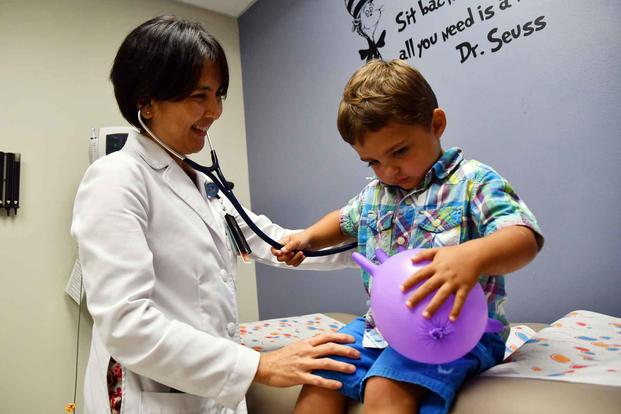The Defense Health Agency has a new mission statement that its director says is more appropriate for a medical system that serves family members, retirees and their families in addition to active-duty personnel.
Army Lt. Gen. Telita Crosland said the new statement, "The Defense Health Agency supports our nation by improving health and building readiness -- making extraordinary experiences ordinary and exceptional outcomes routine," is "about improving health" for all, compared with previous iterations that focused primarily on military readiness.
"Coming out of five years of transition, the [previous] message was very clear that it was all about readiness, and 5.6 million of our beneficiaries could not see themselves in that statement," Crosland told members of the Defense Health Board earlier this month, referring to nonuniformed beneficiaries of the military health system.
Read Next: Air Force's 9th Bomb Squadron Commander Fired After Just a Couple of Months on the Job
The Defense Department launched a massive reform of its health system following passage of the 2017 National Defense Authorization Act, shifting management of 51 hospitals, 424 health clinics and 248 dental clinics from the military services to the Defense Health Agency, and changing the focus of the Army, Navy and Air Force's medical commands to providing combat and in-garrison care for military personnel.
The previous mission statement -- "We support the National Defense Strategy and Service Military Departments by leading the Military Health System as an integrated, highly-reliable system of readiness, medical training, and health" -- reflected an emphasis on serving the warfighter, but it fell short in noting that "readiness" means improving health for all patients, according to Crosland.
"When we improve health, whether it be someone wearing a uniform, their family member or someone who has worn the uniform and their family member, you improve readiness. Extraordinary experiences and exceptional outcomes is how you go about doing that," Crosland told the board.
The military health system has come under fire in the past several years for staffing shortages that have pushed patients into community care, some in locations where area health systems cannot support the influx of patients.
An investigation released by the Defense Department inspector general in April 2022 found that shortages, along with deployments and further planned reductions of medical personnel, left facilities stretched thin and contributed to provider burnout.
In some cases, the shortages caused military treatment facilities to decrease the number of inpatient or intensive care beds and send more active-duty personnel to civilian physicians for care.
Crosland said that, to improve access and care, the Defense Health Agency is focusing on better integration between the military facilities and the Tricare network, and on working closely with the service medical commands to "stabilize the system."
DHA has ramped up recruiting and hiring and reduced its timeline for hiring, and it is preparing to launch varying partnerships with the Department of Veterans Affairs in seven geographic areas that will have the VA and DoD providing staff and sharing expertise and clinical training opportunities for both VA and DoD providers.
The locations include Joint Base Elmendorf-Richardson and the VA Alaska Health System; Naval Medical Center Portsmouth and the Hampton VA Medical Center in Virginia; Madigan Army Medical Center and the Seattle VA Medical Center; Eglin Air Force Base, Naval Hospital Pensacola and the VA Gulf Coast Health Care System, and MacDill Air Force Base and VA Tampa Health Care System in Florida; Evans Army Community Hospital and the VA Eastern Colorado Health Care System; and Blanchfield Army Community Hospital and the VA Tennessee Valley Health Care System.
"It's a definite approach to a symbiotic relationship where it makes sense for the DoD and it makes sense for the VA," Crosland said in a briefing to the board. "They aren't all the same type of agreements. In some cases, the VA is going to come into our facilities that have space for their staff and their patients, and we get that clinical training, opportunities to keep our clinical skills sharp. … In other cases, we may be looking at lease agreements with VA. It's not exactly one size fits all."
The partnerships are expected to begin in the next two to three months, according to Crosland.
Defense Health Agency spokesman Peter Graves said that, despite the changes, the core mission of the agency has not changed. He called DHA an "evolving organization" and said Crosland is "focusing on the next phase of this evolution."
"The DHA continues to support the National Defense Strategy, service military departments and combatant commands, as well as deliver health care to the 9.5 million beneficiaries we are privileged to serve," Graves wrote in an email to Military.com.
-- Patricia Kime can be reached at Patricia.Kime@Military.com.












